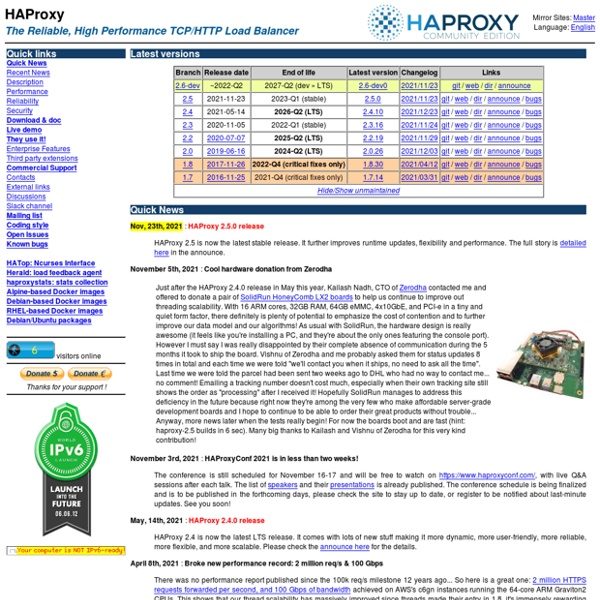



Introducing Mantrid Back when we were first developing Epio, we started off using HAProxy as our load balancer. HAProxy is a fine piece of software, and performed quite well for a while, but it quickly started having issues as we got more sites. The main issue was that Epio has at least two (and often more) hostname-matching rules for each app we host, and we have rather a large number of apps - numbering in the thousands at the time we're talking about, and more these days.
How To Set Up A Load-Balanced MySQL Cluster With MySQL 5.1 Version 1.1 Author: Peter Okupski <okupski [at] widzew [dot] net> Last edited 18/12/2013 This tutorial is based on Falko Timme's tutorial for MySQL Cluster 5.0. It shows how to configure a MySQL 5.1 cluster with five nodes: 1 x management, 2 x storage nodes and 2 x balancer nodes. This cluster is load-balanced by an Ultra Monkey package which provides heartbeat (for checking if the other node is still alive) and ldirectord (to split up the requests to the nodes of the MySQL cluster).
NGINX NGINX is a free, open-source, high-performance HTTP server and reverse proxy, as well as an IMAP/POP3 proxy server. NGINX is known for its high performance, stability, rich feature set, simple configuration, and low resource consumption. NGINX is one of a handful of servers written to address the C10K problem. Unlike traditional servers, NGINX doesn’t rely on threads to handle requests. BIND An authoritative DNS server answers requests from resolvers, using information about the domain names it is authoritative for. You can provide DNS services on the Internet by installing this software on a server and giving it information about your domain names. The BIND 9 documentation includes a description of the Primary/Secondary/stealth secondary roles for authoritative servers. Response Rate Limiting (RRL) is an enhancement to named to reduce the problem of “amplification attacks” by rate-limiting DNS responses.
Virtual Router Redundancy Protocol The Virtual Router Redundancy Protocol (VRRP) is a computer networking protocol that provides for automatic assignment of available Internet Protocol (IP) routers to participating hosts. This increases the availability and reliability of routing paths via automatic default gateway selections on an IP subnetwork. VRRP provides information on the state of a router, not the routes processed and exchanged by that router. Each VRRP instance is limited, in scope, to a single subnet. It does not advertise IP routes beyond that subnet or affect the routing table in any way. VRRP can be used in Ethernet, MPLS and token ring networks with Internet Protocol Version 4 (IPv4), as well as IPv6.
.htaccess snippets to optimize your website All of the snippets below have to be pasted into your .htaccess file, which is located on the root of your Apache server. Waring: Always make sure you have a working backup before editing your .htaccess file! Force trailing slash Many clients of mine asked me for always having a trailing slash at the end of their urls. Looks like it’s great for SEO. The following snippet will alwyas add a trailing slash to your site urls. Introduction to MySQL Cluster Notes from the Introduction to MySQL Cluster talk at the 2004 MySQL User's Conference... First we're seeing an overview of the NDB architecture. If you've never seen it before, think "Oracle RAC without shared storage" and you're 95% of the way there. The core NDB engine is a new storage engine inside MySQL. It provides transactions, replication, on-line backups, crash recovery, hash and tree indexes, on-line index builds, auto-detection of a failed node and re-sync when it comes back up. There are rolling upgrades, which provide a way to upgrade things without a disruption of service.
Decorators – uWSGI The uWSGI API is very low-level, as it must be language-independent. That said, being too low-level is not a Good Thing for many languages, such as Python. Decorators are, in our humble opinion, one of the more kick-ass features of Python, so in the uWSGI source tree you will find a module exporting a bunch of decorators that cover a good part of the uWSGI API. Notes¶ Signal-based decorators execute the signal handler in the first available worker. If you have enabled the spooler you can execute the signal handlers in it, leaving workers free to manage normal requests.
RequestReduce brings immediate Yslow and Google Page Speed score improvements not to mention a faster site! Since March I have been working in my “free” time on a framework to reduce the number and size of HTTP requests incurred from loading a web page. In short it merges and minifies css and javascript on your page and automatically sprites and optimizes css background images. All this is done on the fly (with caching) with no code changes or configuration required.